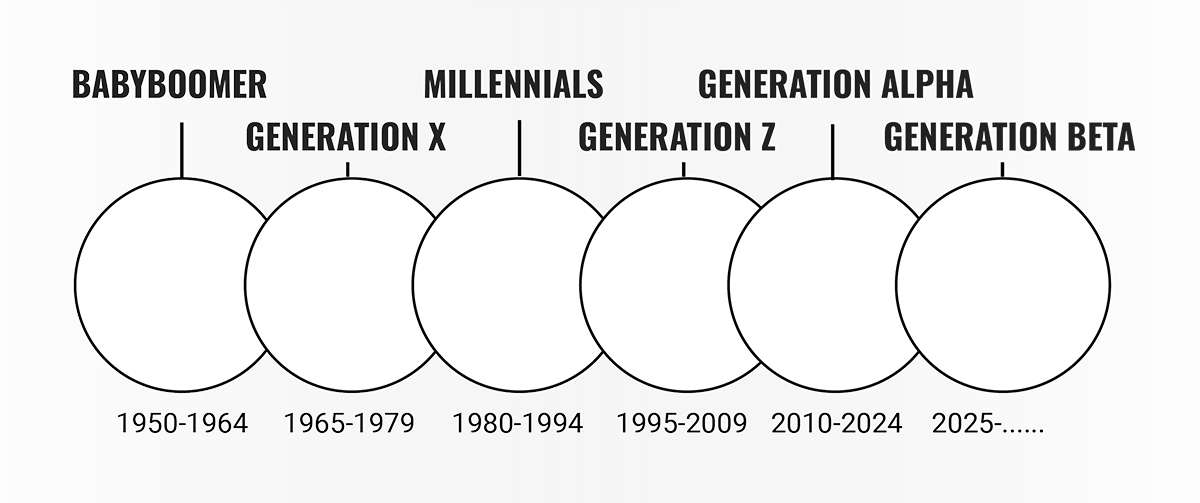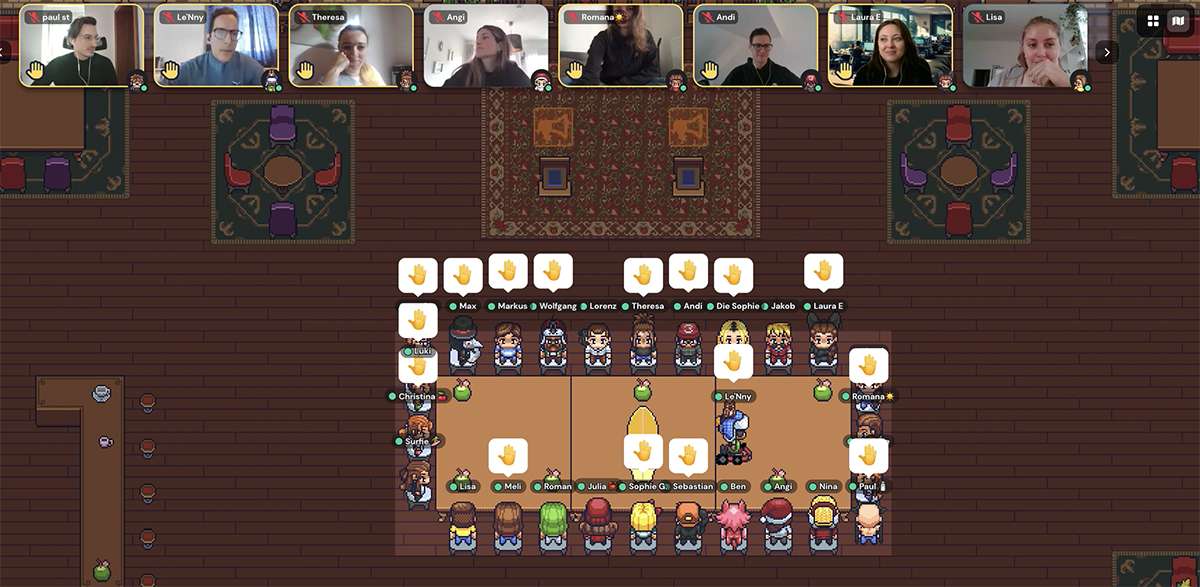The concept of New Work is changing the structures of our everyday work. Undoubtedly, the term has been one of the most used HR trend words over the last few years. Younger generations associate the term New Work with automatization, flexibility, personal development, fulfillment and flat hierarchies. However, the definition behind New Work is digs much deeper.
The term has become a highly used buzzword, leaving employers at a loss as to what these need entail and where they stem from. So how are employers supposed to understand the trend, the new needs and where they stem from? To answer this questions, we explain the trend New Work by using scientific models and investigate how the concept can increase job satisfaction.
Although New Work has become particularly popular over the course of the past years, the original definition dates back to the early 1980s. Back then, Fritjhof Bergmann, a U.S.-Austrian social philosopher and anthropologist, founded a counter-model to socialism called the “New Work” movement. In his opinion,”Old Work” is anchored in the industrial society and represents outdated work models (organizational culture models), such as traditional shift work. The central values of Bergmann’s theory are autonomy, freedom and participation in a community. Bergmann emphasizes that the essence of New Work is based on people’s wishes to accomplish work they truly believe in. Nowadays, New Work is used as a collective term for all new work forms and benefits that have emerged against the backdrop of Bergmann’s definition. Globalization, digitalization and demographic changes are crucial factors in the theory of New Work.
What is New Work? Our Definition
What is contentment? What a person feels when thinking about contentment is highly individual. However, the way contentment forms in our brains is always the same. In an interview with brain researcher Dr. Bernd Hufnagl, he tells us: “we feel content when our brain creates a positive prediction of how we fulfill our needs in the future.” When our brain believes this prediction, we feel satisfied. Whether a prediction is positive or negative is based on
Example: You are hungry and therefore feel the need to satisfy that hunger. You know that there is a slice of pizza waiting for you in the fridge. Being an optimist, your brain estimates there is only a small chance that it has been eaten by someone else. With a feeling of contentment, you walk to the refrigerator.
The feeling of contentment can fluctuate depending on how we assess the future in terms of our needs. However, employee satisfaction increases when organizations ensure that employees’ prediction of the future turns out to be positive. This happens when employees can look back on past positive experiences.
In contrast to satisfaction, the feeling of happiness always arises when we have a need and this need is satisfied. We release “endorphins”, the so-called happiness hormone. So, happiness, describes the sensation we feel when endorphins are released in our body. A lack of needs equals no endorphins and therefore no feeling of happiness. Without a positive prediction of happiness, no satisfaction.
This neurological understanding is important to explain needs, motivation and New Work in the rest of this article.
Enough of scientific theory, because needs are subject to environmental change, trends and generally difficult to influence by employers. “To create satisfaction through work, the environment must meet the individual conditions as well as those of the labor market,” Dr. Bernd Hufnagl describes.
Striving for contentment: finding fulfillment through work
What are the needs behind New Work, and why are they so relevant right now? Clearly, some employee needs are currently in vogue, while others are not. But why is that? A look at Maslow’s hierarchy of needs helps us to better understand, differentiate, categorize and subordinate needs.
Maslow distinguishes between deficiency and growth needs. The model ranks some needs over others in terms of priority. We need water more urgently than a Ferrari, for example. Therefore, physiological needs form the base for individual needs and self- actualization. The first three categories form the so-called deficiency needs. If they are not met regularly, physical or psychological suffering may be the consequence.
Towards the top, the hierarchy deals with cognitive and emotional needs. These include, among other things, the aspect of self-actualization. These categories are called growth needs, and they can never be completely satisfied.
Maslow’s hierarchy of needs has never been scientifically proven and is controversial. Nevertheless, it is a common model to better understand needs and New Work.
Frederick Herzberg’s two-factor theory is also relevant for our New Work definition. Here, the focus is motivation, specifically in the context of work. In terms of needs, Herzberg distinguishes between motivators and hygiene factors (fun read: Serious and not so serious job motivation quotes).
Hygiene factors can be compared with Maslow’s deficiency needs. If they are fulfilled, dissatisfaction is prevented. They are often taken for granted, such as a salary or job security. They do not drive satisfaction, but merely prevent dissatisfaction. For example, ongoing conflicts with supervisors or colleagues make workers dissatisfied. However, positive interpersonal relationships at work alone do not increase job motivation ad infinitum.
Motivators, on the other hand, have to do with the content of work. In “Old Work” these aspects were missing, which did not necessarily lead to dissatisfied employees. In the context of work, motivators refer to needs like recognition, responsibility, success and further development.
Another important concept is motivation. It always arises when we have the prospect of fulfilling a need. For example, if we are offered the prospect of a promotion as an incentive, we are willing to make an effort to obtain it. This willingness to expend a higher level of energy is what we call motivation.
What do different generations expect from New Work?
All employees want to experience contentment. We now explored how contentment arises. And although the needs of employees are very individual, certain groups have opinions in common.
Gen Z want work and travel, millennials want careers and baby boomers want secure jobs – you’ve probably heard these and other clichés before. And in many cases they hold some truth, but why?
With the models presented, we can get to the bottom of this question. At first glance, we can see that baby boomers tend to fulfill their need for self-realization outside the context of work. At work, on the other hand, aspects such as potential development, meaningfulness and self-determined action are very important for Gen Y and Z. It is not surprising that there is a lack of understanding and tensions between generations. It’s not about lumping entire generations together, but there are very different approaches to the New Work trend. It is important for employers to take these differences into account, by making use of situational leadership. This makes it easier to understand and fulfill needs. And that makes employees happier.
Did you know?
Even though different generations expect different benefits out of New Work, these all hinge on one thing: Capable leaders, that are able to understand their employees and adapt to their needs. Wondering if you are a good leader? Find out in our article on the 9 ultimate warning signs of bad leadership.
This is why baby boomers don’t want to know about New Work
Baby boomers grew up in the economic boom of the postwar era. The parents of this generation were busy with post-war reconstruction. They were engrossed in their jobs and maintaining the family. There was often little time for parenting, affection, security and attention.
Many baby boomers were not concerned with individual needs and their self-realization until later in life. The young people’s demand for more self-fulfillment in the work context is, therefore, incomprehensible to them. Their opinion is, that “the young have everything anyway”. For them, New Work is a prosperity problem. They are not entirely wrong with this assessment. The needs resulting from New Work were only made possible by the further development and prosperity of our Western society.

Baby Boomers: Following the bleak aftermath of a world war, an immense surge of children was born, marking the advent of the baby boomers, who arrived between 1946 and the mid-1960s, heralding a fresh beginning and instilling the younger generation with optimism for a brighter future; nevertheless, time has a peculiar ability to distill the essence of reality.
Some typical traits associated with baby boomers include being hardworking, ambitious, goal-oriented, competitive, optimistic, idealistic, resourceful, independent, socially conscious, and valuing personal fulfillment and self-expression. They often prioritize career advancement, are known for their work ethic, and have a strong sense of loyalty towards their employers. Baby boomers also tend to value traditional institutions and may have a more hierarchical view of organizations. They experienced significant cultural and social changes during their formative years, including civil rights movements, the sexual revolution, and advancements in technology.
Derived from the hierarchy of needs, work has a more utilitarian status for baby boomers. They want to provide security and prosperity for themselves and their families, and use work as a means to meet lower-level needs. Baby boomers have internalized this expectation of work and find it difficult to change this attitude. Even when the house is paid off and financial security is assured, baby boomers rarely use work for self-fulfillment. More often, they seek it in their private lives. If we observe this form of self-actualization in middle age, we like to talk about a “midlife crisis.” When dad starts a new hobby every month. Or when mom embarks on a new career path at 50, including a whole new degree, of course. It’s actually a great thing when people think about and realize their own potential in life. It’s even better when people start asking themselves these questions at a younger age. If you believe our definition of New Work, the younger generation is less likely to be affected by a midlife crisis.
A breath of fresh air: That’s what young talents want from New Work
The children of the baby boomers and the following generation have a very different attitude towards this issue. They often have to hear that they “have everything anyway”. Especially from the very people who made this security possible for them. Gen Y and Z grew up with parents who always encouraged them in their actions and took away the fear of financial insecurity. They have grown up thinking that all doors are open to them and surround themselves with a supportive social environment.
 Millennials (Generation Y) : In the tapestry of humanity’s journey, a generation emerged, brimming with vibrant dreams and boundless potential. Born between 1980 and 1994/1996, millennials, the pioneers of a new era, carving their path through the complexities of a rapidly evolving world.
Millennials (Generation Y) : In the tapestry of humanity’s journey, a generation emerged, brimming with vibrant dreams and boundless potential. Born between 1980 and 1994/1996, millennials, the pioneers of a new era, carving their path through the complexities of a rapidly evolving world.
Some typical traits associated with millennials include being tech-savvy, adaptable, socially conscious, entrepreneurial, open-minded, and inclined towards collaboration and teamwork. They are often characterized as being highly educated and valuing continuous learning and personal development. Millennials tend to prioritize work-life balance, seeking flexibility and purpose in their careers. They are also known for their inclination towards sustainability, diversity, and inclusion, advocating for social justice and equality. Additionally, millennials are adept at leveraging technology and social media for self-expression, activism, and networking. They value experiences over material possessions and seek meaningful connections in both personal and professional relationships.
As a result, Gen Y and Z regularly fulfill their hygiene factors anyway. And not only regularly, but also quickly. Thanks to digitalization and prosperity, young people are used to releasing endorphins quickly and easily. The next date is just a few Tinder swipes away. The hardships that baby boomers had to go through to get there are only seen in movies these days. That’s why younger generations don’t want to spend a lot of time trying to fulfill a need. They are simply not used to it, and motivation drops rapidly as soon as the first successes are not noticeable. Employers can complain about this or ensure that they adapt the work environment and work processes to the new conditions.
In order to frequently release endorphins, we at teamazing work with different methods. For example, we have our own Slack channel where positive customer feedback is shared. In our virtual office (remote workspace), the gong is sounded when someone sells an order. So even in the virtual space, we’ve found a variety of effective and quick ways to regularly satisfy employee needs.
 Generation Z: In the grand tapestry of human existence, a new chapter unfolds with the rise of Generation Z, a cohort brimming with boundless energy, unyielding determination, and an unwavering commitment to shaping the world.
Generation Z: In the grand tapestry of human existence, a new chapter unfolds with the rise of Generation Z, a cohort brimming with boundless energy, unyielding determination, and an unwavering commitment to shaping the world.
Generation Z, often called Gen Z, is characterized by being tech-native, diverse, socially conscious, entrepreneurial, adaptable, and driven by authenticity. They embrace technology, value inclusivity, actively engage in social causes, possess an entrepreneurial spirit, adapt quickly to change, and prioritize genuine connections.
New Work also for “Blue-Collar Workers”?
Many of the New Work benefits are designed for an exclusive occupational group, namely knowledge or white-collar workers. Blue-collar workers (we don’t really like this term) or employees whose physical presence is required are often not or cannot be included. They include, for example, construction workers, production workers, and healthcare workers. Unfortunately, their skills and talents can only be used to a limited extent in the home office. Precisely because these occupational groups are often forgotten in the New Work context, employers must listen carefully to their needs.
White-Collar Worker: The Figurehead of New Work
White-collar workers are at the center of most New Work discussions. Basically, occupational groups with high wages, digital work tools and high competition on the employer market are already further ahead in the New Work trend. There, many work processes have already been digitized and innovative working methods and models have been integrated.
The 4 trendiest New Work needs and how to fulfill them
Unfortunately, many companies remain with the trendy New Work buzzwords in the job advertisement. For a positive prediction of need fulfillment and thus employee satisfaction, needs must actually be met and change actively lived. If you are serious about New Work, you need a change in mindset and corporate culture. In addition, every employee is different and therefore has very individual needs and is often not even aware of them. This is precisely why leadership plays a crucial role within New Work. On the one hand, leaders help their employees to develop the needs that are right for them and accompany them as coaches in fulfilling them. On the other hand, they act as role models in the cultural change and actively exemplify the new values. In any case, a fruit basket in the office is not the right way to go.
The needs for transparency, flexibility, purpose and opportunities for further development are currently particularly trendy for the majority of all occupational and age groups. That is why we have selected these needs to present them in more detail and to show how they can be realized:
What is your definition of New Work?
1.Transparency
On the one hand, greater transparency refers to internal aspects of the company that not all employees may be confronted with on a daily basis. Knowledge of important figures, liquidity, profitability and turnover rates not only promotes trust in management, but also involves employees in corporate processes and development. The goal of this New Work trend is for employees to satisfy their need for self-fulfillment with the help of intrapreneurship.
In addition, the exchange between team members is also an important aspect of transparency. This naturally includes an open feedback culture. Often underestimated: If colleagues know each other’s activities, this promotes collaboration, communication and interpersonal connection.
For the latter, the daily concept we work with at teamazing is particularly well suited. This is a 10-minute meeting that takes place every day at the same time. There we exchange information about the activities of the current and previous day, talk about work progress, possible problems and learnings.
2. Remote and flexible work
These two aspects are probably the most frequently mentioned incentives in connection with New Work. This need is particularly close to the hearts of the younger generation, which is striving for more flexibility. On the one hand, because self-determined work is important to them, and on the other, because it is more family-friendly. Incentives such as Workations or virtual offices become more and more popular.
See also: Remote Teams Management for Beginners
3. Personal Development
People are at the center of New Work. The new understanding moves away from the idea that employees are resources that are optimized for maximum profit. Within this need, employees want their individual talents, potentials and interests to be seen and promoted.
This starts with recruiting. Qualified workers today do not chase jobs. Companies are much more likely to apply to young talents. That’s why the focus should be on the applicant’s personal perspective right from the first meeting: How can you best develop their potential and use it to everyone’s delight? The onboarding process should also be as personal as possible and give the newcomer the feeling of being valued and welcomed.
It is in the employer’s interest to provide regular competency development opportunities. The further development must not only concern professional competencies, but also personal aspects.
At teamazing, we offer our employees a start during their studies. In the course of their career, development stations await them – including training, workshops and practical experience – such as experience builders, event managers, team trainers and, in the future, consulting. Current topics are also addressed. For example with a resilience workshop during the Ukraine crisis, which helped to better deal with uncontrollable stressors. In a personal as well as in a work-related context.
4. Purpose
Purpose may sound like a classic New Work buzzword, but it is an important decision-making factor when it comes to choosing a job, especially for the younger generation. According to studies, companies with a sense of purpose have higher employee satisfaction and can retain workers over the long term. Young people in particular want to leave their own footprint on the world through their work and change it for the better.
But employees don’t just strive for purpose in their area of responsibility. They also want the vision of the entire company to be meaningful. Only with clearly communicated values can employees identify and work toward a common goal. These objectives are an essential part of the corporate culture.
Bottom line
New Work means, above all, giving employees the opportunity to realize themselves through their work. The fact that this can take on different dimensions for different generations and occupational groups can be understood using Maslow’s hierarchy of needs. These needs should already be realized within the team. Within a strong team, needs such as praise, co-determination, trust, self-determined action and appreciation are already combined. Our brilliant guide will tell you how to achieve those aspects, especially in virtual teams. With the help of this understanding, trendy New Work needs do not have to remain empty buzzwords, but can be implemented by employers.
Fundamentally, however, not everyone needs to strive to find self-fulfillment through work. New Work should never be forced upon anyone. It is much more important to address the individual needs of employees. After all, New Work is as diverse as each employee themselves.
VIDEO: Ted Talk explaining New Work
FAQs New Work
Which methods are often associated with New Work?
Teams practicing New Work often put a lot of emphasize on agility and more flexibility. This may be related to the fact that, in current competitive job markets, fast reactions to problems can make or break success. Many modern teams also find themselves tired of the usual bureaucratic workflows, that are just no longer as effective as they once were. Employees also value more freedom in their work, and want to make use of a more flexible timetable.
What is the most important aspect of New Work?
When people think about New Work, one of the most prominent things that come to mind are remote work, flexible work schedules and flat hierarchies. However, there are no rules to how New Work should look like. The model is all about empowering employees and helping them find purpose and joy in their work. That’s why New Work can be applied to almost any industry.















